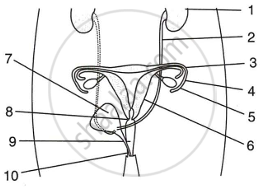Advertisements
Advertisements
Question
Explain the process of fertilization in human beings.
Solution
Fertilisation:
- Fertilisation takes place when the sperm unites with the egg.
- The sperms enter through the vaginal passage and travel upwards and reach the oviduct.
- In the oviduct, one of the sperms fuses with the egg and the fertilisation is completed.
APPEARS IN
RELATED QUESTIONS
Name any three parts of the female reproductive system in human beings. Write one function of each.
Name the parts of the human female reproductive system where
i. fertilisation takes place
ii. implantation of the fertilised egg occurs
Draw a sectional view of human female reproductive system and label the part where
(i) eggs develop.
(ii) fertilisation takes place.
(iii) fertilised egg gets implanted.
Mention the total number of chromosomes along with the sex chromosomes that are present in a human female and a human male. Explain how in sexually producing organisms the number of chromosomes in the progeny remains the same as that of the parents.
When a cell reproduces, what happens to its DNA?
The pituitary hormone which stimulates contraction of uterus during child birth.
Give technical terms for Thin walled sac of skin which covers the testes
Given below are diagrams showing the different stages in the process of fertilisation of an egg. in the human female reproductive tract.
Study the diagrams and answer the questions:
1) Arrange the letters given below each diagram in a logical sequence to show the correct order in the process of fertilisation.
2) Where does fertilisation normally take place? and What is ‘Implantation’ that follows fertilisation?
3) Mention the chromosome number of the egg and zygote in humans.
4) Explain the term ‘Gestation’. How long does Gestation last in humans?
5) Draw a neat, labelled diagram of a mature human sperm.
Give biological explanations for The placenta is an important structure for the development of a foetus
What are the organs in humans which produce the gametes?
Where in the human body does an ovum get fertilised?
For how much time does menstruation last in human females (or women)?
What name is given to the fusion of sperm and ovum?
What is gestation period? How much is the gestation period in humans?
What is the life support system of a fetus?
Name the organs which produce ova (or egg cells) in human females.
Which one of the following best describes the function of the umbilical cord? It :
(a) feeds the embryo with digested substances.
(b) conveys nutrients and wastes to and from the embryo respectively
(c) removes waste matter from the embryo to the mother's blood.
(d) supplies oxygenated blood from the mother to the embryo.
During adolescence, several changes occur in the human body. Mark one change from the following associated with sexual maturation in boys.
The male gametes in a flower and in a human are produced respectively in :
(a) stigma and ovary
(b) anther and style
(c) ovary and testes
(d) anther and testes
Given below is a diagram of two systems together in the human body.
 |
- Name the systems.
- Name the parts numbered 1-10.
- Describe the functions of the parts 3, 4, 5 & 6.
- What will happen if the part 3 on both sides gets blocked?
Trace the path of sperms from where they are produced in human body to the exterior.
Describe in brief the role of ureter in human male reproductive system.
Draw a diagram of human female reproductive system and label the part.
(i) That produces eggs.
(ii) Where fusion of egg and sperm take place.
(iii) Where zygote is implanted.
What happens to human egg when it is not fertilized?
The vagina is a muscular tube.
Answer the following question.
What is contraception? List three advantages of adopting contraceptive measures.
Define the four stages in the uterine cycle.
What do you understand by an inguinal hernia?
Differentiate
Sexual Reproduction and Asexual Reproduction.
Choose the Odd One Out:
Choose the Odd One Out:
Multiple Choice Question:
What will happen if the temperature of the scrotal sacs temporarily goes to about 2°C lower than body temperature?
Freshly released human egg has ______.
The living organisms can be unexceptionally distinguished from the non-living things on the basis of their ability for ______.
Match Columns I and II and select the correct option.
| Columns I | Columns II | ||
| i. | Transfer of sperms in the female genital tract. | a. | Gestation |
| ii. | Delivery of baby | b. | Fertilization |
| iii. | Fusion of male and female gamete. | c. | Parturition |
| iv. | Formation of sperms and ovum | d. | Insemination |
| e. | Gametogenesis |
A zygote is formed by the fusion of a male gamete and a female gamete. The number of chromosomes in the zygote of a human is ______.
Given below is a group of terms. In the group, one pair indicates the relationship between the two terms. Rewrite and complete the second pair on a similar basis.
Female gonad : Ovaries :: Male gonad : ______.
